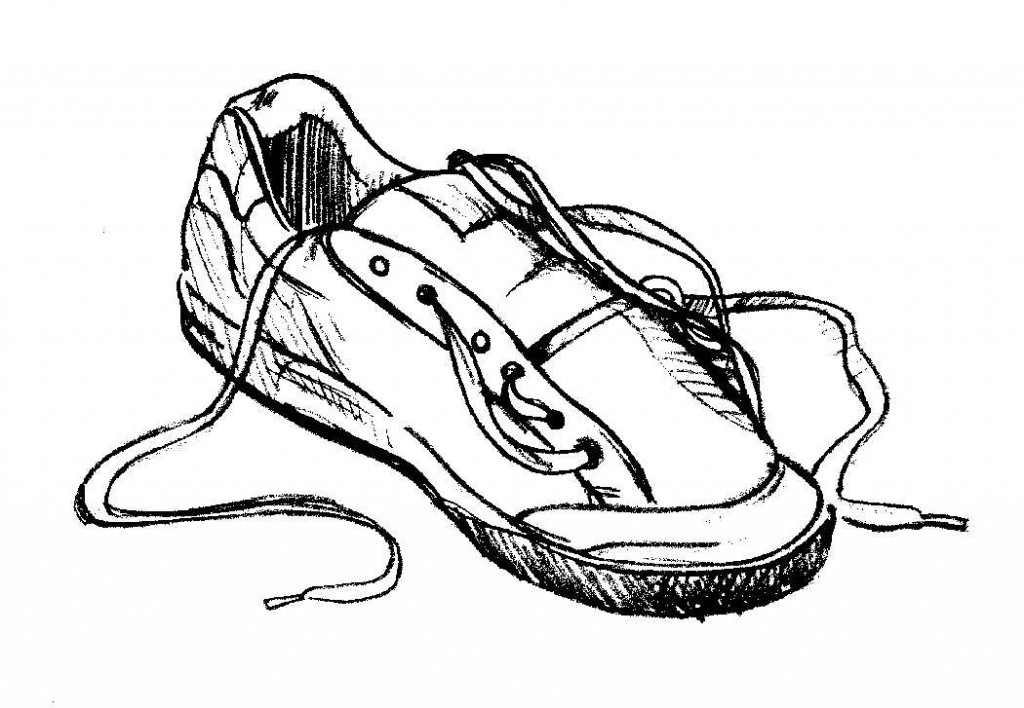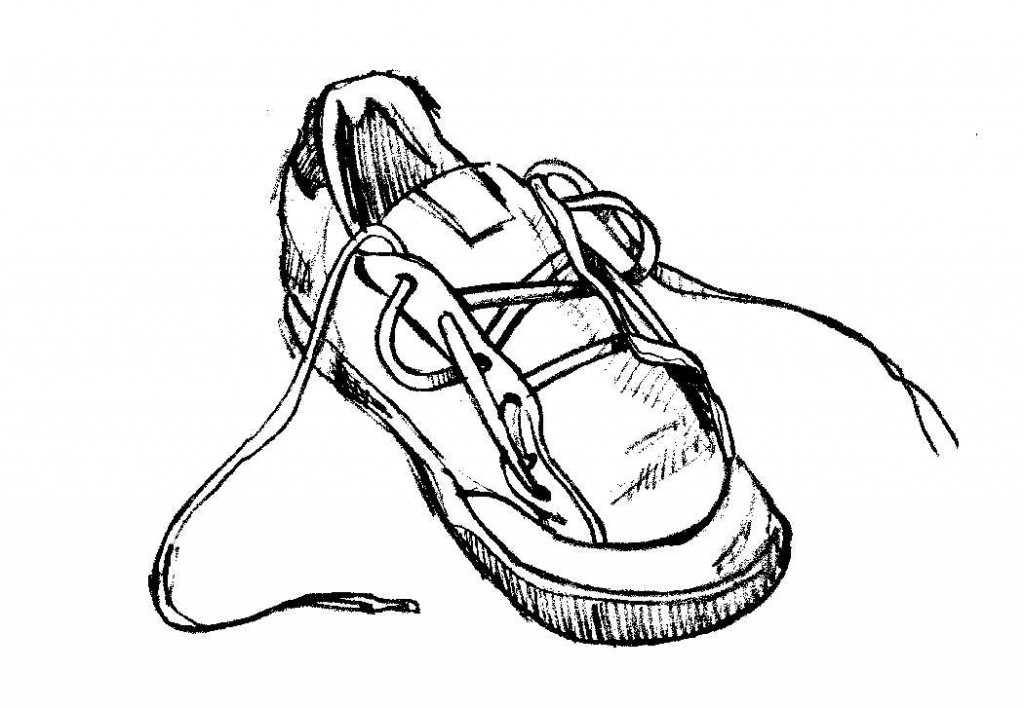Footbag Shoe Lacing Instructions
Freestyle Fame On A Shoestring
*NOTE – Make sure the shoe fits before modifying. Shoes cannot be returned after modifications occur.
Ever try playing baseball without a mitt? What about basketball without a hoop? In each of these sports, the game revolves around a primary object, that is, the baseball or the basketball. However, secondary equipment (i.e., the mitt or the hoop), for which there is no practical substitute, is essential to the optimal playing of each game. Wearing a gardening glove on your left hand may help you field a line drive, but it’s no substitute for a baseball mitt. A dart board would give you something at which to shoot a basketball, but hey, you can’t rip twine on a dart board.
So, too, the sport of footbag has an obvious primary object, the footbag itself. However, the focus of this article is secondary equipment that is essential to the optimal playing of the game and for which there is no practical substitute. In our sport that secondary equipment is SHOES. Through the years players have run across shoes that have worked particularly well for footbag. There were the Nike Avenger, the Kaepa 165, the Nike Wimbledon Court, the le coq sportif Super Ashe, and the Adidas Rod Laver. None of these shoes are in production anymore. I know several players who have wisely hoarded extra pairs of Avengers and 165’s. However, the good news is that a shoe is now on the market which is as good or better than any of the venerable shoes I mentioned earlier. It is the Quantum footbag shoe.
So let’s assume that you’ve acquired a quality primary object (a footbag ) and the recommended secondary equipment (a pair of Quantum footbag shoes). The next option you have is to make one or more of the several modifications to which the remainder of this article is devoted. (If you feel that any of these modifications are cheating, then don’t do it! However, if you’re into freestyle and you want the style of your shoes to be as free as your moves, then read on.) If you’re just starting into the basics of freestyle, delays and such, these modifications will definitely be a big help. Get some Quantums and start carvin’ on them. You’ll be carvin’ out new freestyle moves much sooner with these than with conventional shoes. The reason for this is simple: Although failure can be a good teacher, success is the ultimate teacher in this activity. These shoes, and the suggested modifications, will more quickly enable you to successfully execute the moves you’re working on! I should also mention that most, if not all, of these modifications will work on your old pair of Avengers, 165’s, le coq’s, etc. Let’s jump right in, shall we?
LACING

figure 2
Technique #1: Just lace them up the way you normally would, but start at the third hole rather than the first hole. That’s right, just pretend that those first two holes aren’t even there and lace up. Now put those shoes on and curl your toes a bit. Not only do you have a larger landing deck, you have side walls! The side walls along those first two, unused lacing holes will tend to stand up and keep the footbag on your foot when you go for a toe stall.
Technique #2: This is a lacing method developed by world champion Kenny Shults:
A) Take the lace and run it UP from the BOTTOM through the third hole. Do the same to the third hole on the other side. Even the laces out. You should have something that looks like Figure 2.
B) Without crossing to the other side, run the lace DOWN through the second hole, UP through the first, and then DOWN through the fifth. (No, this is not a misprint.) Do the same to the other side. Your shoe should be looking like Figure 3.

figure 3
C) Now you get to CROSS the lace to the opposite side and go UP through the fourth hole. Without crossing to the other side, go DOWN through the sixth hole (Figure 4). If you’re modifying shoes that have more than seven holes, just lace them up the rest of the way in the conventional manner.
Put your shoes on and tighten the lacings up. You’ll find that this technique actually holds those side walls out for you. It also keeps them a little lower, which may be desirable depending on your style. This technique also has the benefit of turning your shoes into a funky pair of loafers! You can just slip in and out of them while leaving them laced up.

figure 4
Loose Ends:
You’ll notice that with all the lacing techniques in this article you wind up with a lot of extra lace when you go to tie the knot. This can be dealt with in one of four ways:
- Ignore it. (But you may find they get in your way.)
- Tie more knots to take up the excess.
- Cut the darn things off. (However, the frayed ends make it hard to re-lace.)
- Buy some shorter laces! Thirty-six-inch to forty-inch laces seem to be the right size on most shoes with modified lacings.
If you want the excess lace to disappear altogether, use the packer’s knot. This was probably devised by some crafty backpacker who didn’t like getting his shoe laces caught in the underbrush. Here’s how to do it:
- You’ve done the minor surgery, you’ve chosen a lacing technique, you’ve laced up, and you’re about to tie the conventional bow knot. Instead of the bow knot, take the lace and run it back through the last hole, the one that you just came out of, leaving a loop. Do the same to the other side.
- Take the lace on the right and run it though the loop you made on the left. Now take the lace on the left and run it through the loop on the right.
- Take the two ends of the laces and pull until they feel tight enough.
- Take the loose ends and tuck them away, out of sight. I tuck them between the eyestays and the tongue.
Note: Finding a pair of laces that are just the right length is important when using the packer’s knot. That way you don’t have a lot of excess to tuck away.
If you like your shoes so far, read on. I’ve used several different lacing techniques over the years and enjoyed the results. But in true American tradition, I wanted MORE! So here is my contribution to the fine array of freestyle shoe modifications. BAILIN’ PAILS work great for my freestyle, and don’t inhibit my basic kicks at all.
- Step 1: Do the minor surgery outlined in Pre-Lacing Prep above.
- Step 2:
- A) Place a spacer on the lace. I use a semi-flexible piece of 1/4-inch plastic tubing that is 3 1/2 inches long. You may want to experiment with different lengths. (The type of tubing I use is available at most hardware stores.) Run the lace through the tubing before running it through the third holes of your shoe as outlined in Lacing Technique #2A above. (Note: Some people who have tried this prefer placing the tubing at the second hole.)
- B) Run the laces under the tubing (toward the toe) as in Figure 4. This is important because it will arch the tubing back (toward the heel) and hold it down against tongue of the shoe when laced up.
- C) Now just lace up in the conventional manner. Be sure to get the ends of the tubing snug up against the insides of the third holes. Tighten everything up and curl your toes. . .

figure 5
You are now looking at a HUGE landing deck that can best be described as heinous, vulgar, repulsive, etc. (Figure 5). But man, can you ever snag a bag with these pups!
IN CLOSING
As you have seen, the purpose of this article has been to introduce you to the secondary equipment in footbag as well as to outline for you some innovative ways of adapting this equipment to the footbag freestyle game. Regarding the modifications, let me say again that none of them have negatively affected my basic kicks, and all have positively impacted my freestyle tricks! However, that’s just my experience. I suggest you find out for yourself.
By Paul Vorvick and World Footbag




